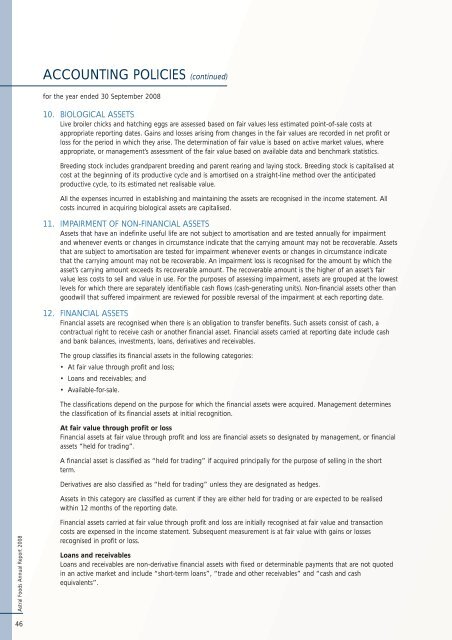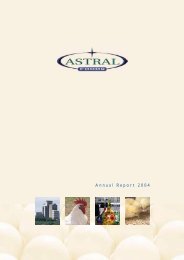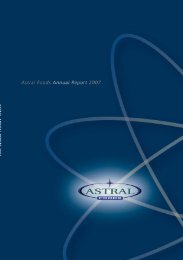Astral Foods Annual Report 2008
Astral Foods Annual Report 2008
Astral Foods Annual Report 2008
You also want an ePaper? Increase the reach of your titles
YUMPU automatically turns print PDFs into web optimized ePapers that Google loves.
ACCOUNTING POLICIES (continued)for the year ended 30 September <strong>2008</strong>10. BIOLOGICAL ASSETSLive broiler chicks and hatching eggs are assessed based on fair values less estimated point-of-sale costs atappropriate reporting dates. Gains and losses arising from changes in the fair values are recorded in net profit orloss for the period in which they arise. The determination of fair value is based on active market values, whereappropriate, or management’s assessment of the fair value based on available data and benchmark statistics.Breeding stock includes grandparent breeding and parent rearing and laying stock. Breeding stock is capitalised atcost at the beginning of its productive cycle and is amortised on a straight-line method over the anticipatedproductive cycle, to its estimated net realisable value.All the expenses incurred in establishing and maintaining the assets are recognised in the income statement. Allcosts incurred in acquiring biological assets are capitalised.11. IMPAIRMENT OF NON-FINANCIAL ASSETSAssets that have an indefinite useful life are not subject to amortisation and are tested annually for impairmentand whenever events or changes in circumstance indicate that the carrying amount may not be recoverable. Assetsthat are subject to amortisation are tested for impairment whenever events or changes in circumstance indicatethat the carrying amount may not be recoverable. An impairment loss is recognised for the amount by which theasset’s carrying amount exceeds its recoverable amount. The recoverable amount is the higher of an asset’s fairvalue less costs to sell and value in use. For the purposes of assessing impairment, assets are grouped at the lowestlevels for which there are separately identifiable cash flows (cash-generating units). Non-financial assets other thangoodwill that suffered impairment are reviewed for possible reversal of the impairment at each reporting date.12. FINANCIAL ASSETSFinancial assets are recognised when there is an obligation to transfer benefits. Such assets consist of cash, acontractual right to receive cash or another financial asset. Financial assets carried at reporting date include cashand bank balances, investments, loans, derivatives and receivables.The group classifies its financial assets in the following categories:• At fair value through profit and loss;• Loans and receivables; and• Available-for-sale.The classifications depend on the purpose for which the financial assets were acquired. Management determinesthe classification of its financial assets at initial recognition.At fair value through profit or lossFinancial assets at fair value through profit and loss are financial assets so designated by management, or financialassets “held for trading”.A financial asset is classified as “held for trading” if acquired principally for the purpose of selling in the shortterm.Derivatives are also classified as “held for trading” unless they are designated as hedges.Assets in this category are classified as current if they are either held for trading or are expected to be realisedwithin 12 months of the reporting date.<strong>Astral</strong> <strong>Foods</strong> <strong>Annual</strong> <strong>Report</strong> <strong>2008</strong>Financial assets carried at fair value through profit and loss are initially recognised at fair value and transactioncosts are expensed in the income statement. Subsequent measurement is at fair value with gains or lossesrecognised in profit or loss.Loans and receivablesLoans and receivables are non-derivative financial assets with fixed or determinable payments that are not quotedin an active market and include “short-term loans”, “trade and other receivables” and “cash and cashequivalents”.46






